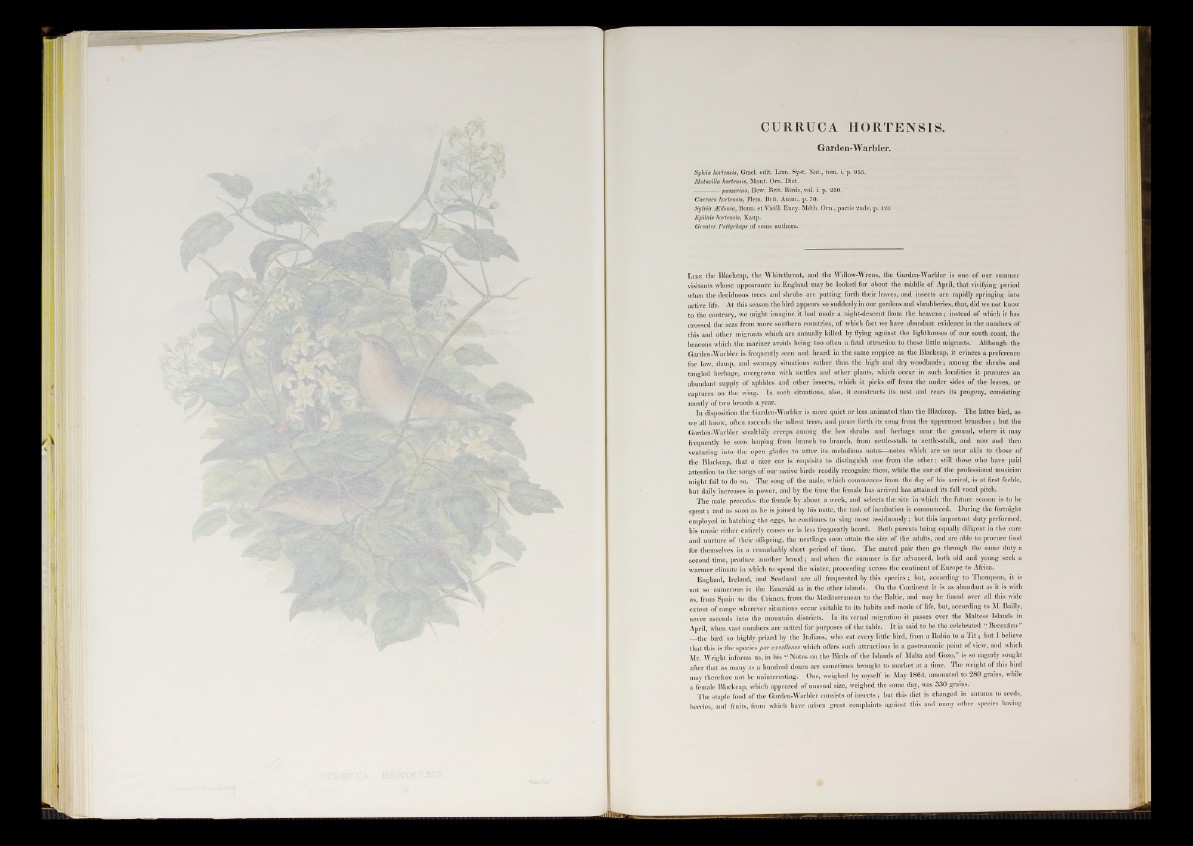
Garde n-W arbler.
Sylvia hortensis, Gmel. edit. Linn. Syst. Nat., tom. i. p. 955.
Motacilla hortensis, Mont. Om. Diet.
------------ passerina, Bew. Brit. Birds, vol. i. p. 250.
Curruca hortensis, Flem. Brit. Anim., p. 70.
Sylvia JEdonia, Bonn, et Vieill. Ency. Méth. Ora., partie 2nde, p. 424
Epilais hortensis, Kaup.
Greater Petlychaps of some authors.
L ik e the Blackcap, the Whitetliroat, and the Willow-Wrens, the Garden-Warbler is one o f our summer
visitants whose appearance in England may be looked for about the middle of April, that vivifying period
when the deciduous trees and shrubs are putting forth their leaves, and insects are rapidly springing into
active life. At this season the bird appears so suddenly in our gardens and shrubberies, that, did we not know
to the contrary, we might imagine it had made a night-descent from the heavens; instead of which it has
crossed the seas from more southern countries, of which fact we have abundant evidence in the numbers of
this and other migrants which are annually killed by flying against the lighthouses of our south coast, the
beacons which the mariner avoids being too often a fatal attraction to these little migrants. Although the
Garden-Warbler is frequently seen and heard in the same coppice as the Blackcap, it evinces a preference
for low, damp, and swampy situations rather than the high and dry woodlands; among the shrubs and
tangled herbage, overgrown with nettles and other plants, which occur in such localities it procures an
abundant supply of aphides and other insects, which it picks off from the under sides of the leaves, or
captures on the wing. In such situations, also, it constructs its nest and rears its progeny, consisting
mostly of two broods a year.
In disposition the Garden-Warbler is more quiet or less animated than the Blackcap. The latter bird, as
we all know, often ascends the tallest trees, and pours forth its song from the uppermost branches; but the
Garden-Warbler stealthily creeps among the low shrubs and herbage near the ground, where it may
frequently be seen leaping from branch to branch, from nettle-stalk to nettle-stalk, and now and then
venturing into the open glades to utter its melodious notes—notes which are so near akin to those of
the Blackcap, that a nice ear is requisite to distinguish one from the other: still those who have paid
attention to the songs of our native birds readily recognize them, while the ear of the professional musician
might fail to do so. The song of the male, which commences from the day of his arrival, is at first feeble,
but daily increases in power, and by the time the female has arrived has attained its full vocal pitch.
The male precedes the female by about a week, and selects the site in which the future season is to be
spent; and as soon as he is joined by his mate, the task o f incubation is commenced. During the fortnight
employed in hatching the eggs, he continues to sing most assiduously; but this important duty performed,
his music either entirely ceases or is less frequently heard. Both parents being equally diligent in the care
and nurture of their offspring, the nestlings soon attain the size of the adults, and are able to procure food
for themselves in a remarkably short period of time. The mated pair then go through the same duty a
second time, produce another brood; and when the summer is far advanced, both old and young seek a
warmer climate in which to spend the winter, proceeding across the continent of Europe to Africa.
England, Ireland, and Scotland are all frequented by this species; but, according to Thompson, it is
not so numerous in the Emerald as in the other islands. On the Continent it is as abundant as it is with
us, from Spain to the Crimea, from the Mediterranean to the Baltic, and may be found over all this wide
extent of range wherever situations occur suitable to its habits and mode of life, but, according to M. Bailly,
never ascends into the mountain districts. In its vernal migration it passes over the Maltese Islands in
April, when vast numbers are netted for purposes of the table. It is said to be the celebrated Beccafico ”
the bird so highly prized by the Italians, who eat every little bird, from a Robin to a T i t ; but I believe
that this is the species par excellence which offers such attractions in a gastronomic point of view, and which
Mr. Wright informs us, in his “ Notes on the Birds of the Islands of Malta and Gozo,” is so eagerly sought
after that as many as a hundred dozen are sometimes brought to market at a time. The weight of this bird
may therefore not be uninteresting. One, weighed by myself in May 1864, amounted to 280 grains, while
a female Blackcap, which appeared of unusual size, weighed the same day, was 330 grains.
The staple food of the Garden-Warbler consists of insects ; but this diet is changed iu autumn to seeds,
berries, and fruits, from which have arisen great complaints against this and many other species having